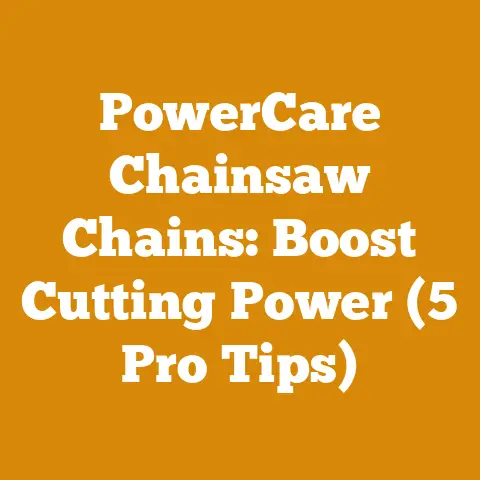How to Make a Stump Rot Fast (5 Pro Arborist Techniques)
How to Make a Stump Rot Fast (5 Pro Arborist Techniques)
Let’s face it: tree stumps are unsightly remnants of tree removal, and they can be a real pain. They get in the way of landscaping, attract pests, and can even pose a tripping hazard. While patience is a virtue, sometimes you just want that stump gone – and gone fast. As someone who’s spent years in the arborist and wood processing world, I’ve seen my fair share of stumps. I’ve learned that while there’s no magic bullet, some techniques significantly accelerate the natural decomposition process. I’m going to share five pro arborist techniques that I’ve personally used and refined over the years to help you get rid of that stump quickly and efficiently.
Why Speed Matters: More Than Just Aesthetics
Before we dive into the “how,” let’s talk about the “why.” Speeding up stump rot isn’t just about aesthetics; it’s about practical benefits:
- Prevents Pest Infestations: Decaying wood attracts insects like termites and carpenter ants, which can then spread to your home or other structures. Faster decomposition minimizes this risk.
- Eliminates Trip Hazards: A low-lying stump can be a dangerous obstacle, especially in areas with children or high foot traffic.
- Reclaims Land: Removing the stump opens up valuable space for gardening, landscaping, or construction.
- Reduces Sprouting: Some tree species stubbornly send up new shoots from the stump, even after the main tree is gone. Faster decomposition reduces the likelihood of this happening.
Key Concepts: Understanding the Rotting Process
To effectively speed up stump rot, it’s essential to understand the basics of decomposition. Here are some key concepts:
- Decomposition: The process by which organic matter breaks down into simpler substances. In the case of wood, this is primarily driven by fungi and bacteria.
- Fungi: Microscopic organisms that feed on wood, breaking down its structure and causing it to rot. Different types of fungi specialize in different types of wood and conditions.
- Moisture: Essential for fungal growth. Wood that is constantly wet will rot much faster than dry wood.
- Nitrogen: A key nutrient for fungi and bacteria. Adding nitrogen-rich materials to the stump can accelerate the decomposition process.
- Surface Area: The more surface area exposed to the elements and microorganisms, the faster the wood will rot.
Technique 1: The “Chop and Soak” Method
This is my go-to method for smaller stumps, especially in areas where I don’t want to use chemicals. It’s simple, effective, and relies on creating the ideal environment for natural decomposition.
Step 1: Preparation and Safety
- Tools: Chainsaw (I prefer a 16-inch bar for this, like a Stihl MS 271 FARM BOSS), axe, drill with a large diameter bit (1/2 inch or larger), garden hose, safety glasses, work gloves, ear protection.
- Safety First: Always wear safety glasses, work gloves, and ear protection when using a chainsaw or axe. Ensure you have a clear work area and that no one is within striking distance.
Step 2: The Chop
- Lower the Stump: If the stump is tall, use the chainsaw to cut it down as close to ground level as possible. Be careful not to hit the ground with the chain, as this will dull it quickly.
- Score the Surface: Use the chainsaw to score the top surface of the stump with crisscrossing cuts. Make the cuts about 2-3 inches deep and 4-6 inches apart. This creates more surface area for moisture and microorganisms to penetrate.
- Chop Notches: Use the axe to chop notches around the perimeter of the stump. These notches should be angled inward, creating pockets that will hold water and debris.
Step 3: The Soak
- Drill Holes: Drill several deep holes (6-8 inches) into the top of the stump using the drill with the large diameter bit. These holes will act as reservoirs for water and nutrients.
- Saturate the Stump: Thoroughly soak the stump with water from the garden hose. Make sure to fill all the holes and notches.
- Maintain Moisture: Keep the stump consistently moist by watering it regularly, especially during dry periods.
Step 4: Add Nitrogen (Optional)
- Nitrogen Boost: To further accelerate the decomposition process, add a nitrogen-rich material to the stump. Good options include:
- Urea Fertilizer: Dissolve urea fertilizer in water and pour it into the holes and notches. Use about 1/2 cup of urea per gallon of water.
- Compost or Manure: Pack compost or manure into the holes and notches.
- Coffee Grounds: Coffee grounds are a great source of nitrogen and can be easily obtained from local coffee shops.
Step 5: Cover (Optional)
- Trap Moisture: Covering the stump with a tarp or plastic sheet can help trap moisture and create a warmer, more humid environment, which is ideal for fungal growth. Secure the tarp with rocks or stakes.
Why This Works:
- Increased Surface Area: The chainsaw cuts and axe notches create more surface area for moisture and microorganisms to penetrate.
- Moisture Retention: The holes and notches act as reservoirs for water, keeping the stump consistently moist.
- Nitrogen Boost: The added nitrogen provides essential nutrients for fungi and bacteria, accelerating the decomposition process.
My Experience: I used this method on a small oak stump in my backyard. I chopped and soaked it, added coffee grounds, and covered it with a tarp. Within a year, the stump was significantly softer and easier to break apart.
Technique 2: The Epsom Salt Method
Epsom salt (magnesium sulfate) is often touted as a natural stump remover. While it doesn’t magically dissolve the stump, it can help dry out the wood, making it more susceptible to fungal attack.
Step 1: Preparation and Safety
- Tools: Drill with a large diameter bit (1/2 inch or larger), Epsom salt, water, funnel, safety glasses, work gloves.
- Safety First: Always wear safety glasses and work gloves when handling Epsom salt.
Step 2: Drill Holes
- Drill Deep: Drill several deep holes (6-8 inches) into the top of the stump using the drill with the large diameter bit. Space the holes about 4-6 inches apart. The more holes, the better.
Step 3: Apply Epsom Salt
- Fill the Holes: Using a funnel, carefully pour Epsom salt into each of the holes until they are full.
- Add Water: Slowly pour water into the holes to dissolve the Epsom salt.
Step 4: Repeat Regularly
- Reapply: Repeat the Epsom salt application every few weeks, or whenever the holes appear dry.
Why This Works:
- Drying Effect: Epsom salt is a desiccant, meaning it draws moisture out of the wood. This drying effect can weaken the wood fibers and make the stump more susceptible to fungal attack.
- Magnesium Sulfate: Magnesium sulfate can also act as a mild poison to the tree, further weakening it.
My Experience: I used this method on a stubborn maple stump. It took several months of repeated applications, but eventually, the stump became noticeably softer and easier to chop apart. It’s a slower process than the “chop and soak” method, but it’s a good option if you prefer a more hands-off approach.
Important Note: The effectiveness of Epsom salt can vary depending on the type of wood and the environmental conditions.
Technique 3: The “Fungus Feast” Method (Using Mushroom Spawn)
This technique involves introducing specific types of wood-decaying fungi to the stump to accelerate the decomposition process. This is a more advanced technique, but it can be very effective.
Step 1: Preparation and Safety
- Tools: Drill with a large diameter bit (1/2 inch or larger), mushroom spawn (oyster mushrooms, shiitake mushrooms, or wine cap mushrooms are good choices), sawdust or wood chips, water, safety glasses, work gloves.
- Safety First: Always wear safety glasses and work gloves when handling mushroom spawn.
Step 2: Choose Your Fungus
- Oyster Mushrooms: Fast-growing and aggressive decomposers, oyster mushrooms are a good choice for a wide range of wood types.
- Shiitake Mushrooms: Slower growing but produce delicious edible mushrooms. They prefer hardwoods like oak and maple.
- Wine Cap Mushrooms: Another edible mushroom that is relatively easy to cultivate and can help decompose wood.
Step 3: Drill Holes
- Drill Deep: Drill several deep holes (6-8 inches) into the top of the stump using the drill with the large diameter bit. Space the holes about 4-6 inches apart.
Step 4: Inoculate with Mushroom Spawn
- Mix Spawn: Mix the mushroom spawn with sawdust or wood chips.
- Fill the Holes: Pack the spawn mixture into the drilled holes.
- Water Thoroughly: Water the stump thoroughly to activate the spawn.
Step 5: Maintain Moisture
- Keep it Wet: Keep the stump consistently moist by watering it regularly.
Why This Works:
- Targeted Decomposition: By introducing specific types of wood-decaying fungi, you can accelerate the decomposition process in a targeted way.
- Edible Mushrooms: Some mushroom species, like oyster mushrooms and shiitake mushrooms, produce edible mushrooms, providing an added bonus.
My Experience: I inoculated a large birch stump with oyster mushroom spawn. Within a few months, I started seeing mushrooms growing on the stump. Over time, the stump became noticeably softer and more decomposed. Plus, I got to enjoy a few meals of fresh oyster mushrooms!
Important Note: Make sure to choose a mushroom species that is appropriate for the type of wood you are trying to decompose. Also, be aware that some mushroom species can be toxic, so be sure to properly identify any mushrooms before consuming them.
Technique 4: The Chemical Stump Remover
Chemical stump removers contain potassium nitrate, which accelerates the decomposition process. This is a faster method than the natural approaches, but it involves using chemicals.
Step 1: Preparation and Safety
- Tools: Drill with a large diameter bit (1/2 inch or larger), chemical stump remover (follow manufacturer’s instructions), water, safety glasses, work gloves, respirator (optional).
- Safety First: Always wear safety glasses and work gloves when handling chemical stump removers. A respirator is recommended to avoid inhaling dust or fumes.
Step 2: Drill Holes
- Drill Deep: Drill several deep holes (6-8 inches) into the top of the stump using the drill with the large diameter bit. Space the holes about 4-6 inches apart.
Step 3: Apply Chemical Stump Remover
- Follow Instructions: Carefully follow the manufacturer’s instructions for applying the chemical stump remover.
- Fill the Holes: Pour the chemical stump remover into the drilled holes.
- Add Water: Add water to the holes to help dissolve the chemical.
Step 4: Wait and Repeat
- Be Patient: The decomposition process can take several weeks or months, depending on the size of the stump and the environmental conditions.
- Reapply: Reapply the chemical stump remover as needed, following the manufacturer’s instructions.
Step 5: Burn (Optional)
- Burn it Out: Once the stump is sufficiently decayed, you can optionally burn it out. This will completely remove the stump and any remaining roots.
- Safety First: Burning a stump can be dangerous. Check with your local authorities to ensure that burning is permitted in your area. Take all necessary safety precautions, including clearing a wide area around the stump and having a water source nearby.
Why This Works:
- Potassium Nitrate: Potassium nitrate is a strong oxidizer that accelerates the decomposition process by breaking down the wood fibers.
- Faster Decomposition: Chemical stump removers can significantly speed up the decomposition process compared to natural methods.
My Experience: I used a chemical stump remover on a large oak stump that was too big for me to handle with natural methods alone. It took several months of repeated applications, but eventually, the stump became soft enough to break apart with an axe. While effective, I prefer natural methods whenever possible due to environmental concerns.
Important Note: Chemical stump removers can be harmful to the environment and should be used with caution. Follow the manufacturer’s instructions carefully and avoid contact with skin and eyes.
Technique 5: The “Stump Grinder” Solution
While not strictly a “rotting” technique, using a stump grinder is the fastest and most effective way to remove a stump. Stump grinders are specialized machines that use a rotating cutting wheel to grind the stump down into small chips.
Step 1: Preparation and Safety
- Tools: Stump grinder (can be rented from most equipment rental stores), safety glasses, work gloves, ear protection, dust mask.
- Safety First: Stump grinders are powerful machines and can be dangerous if not used properly. Read the operator’s manual carefully and follow all safety instructions. Wear safety glasses, work gloves, ear protection, and a dust mask.
Step 2: Clear the Area
- Remove Obstacles: Clear the area around the stump of any rocks, roots, or other obstacles that could damage the stump grinder.
- Mark Utilities: Call your local utility company to mark any underground utilities in the area.
Step 3: Grind the Stump
- Position the Grinder: Position the stump grinder so that the cutting wheel is directly over the stump.
- Start Grinding: Start the engine and slowly lower the cutting wheel onto the stump.
- Move the Grinder: Move the grinder back and forth across the stump, grinding it down in layers.
- Grind Below Ground: Grind the stump down to at least 6 inches below ground level to allow for future landscaping.
Step 4: Fill the Hole
- Remove Chips: Remove the stump chips from the hole.
- Fill with Soil: Fill the hole with topsoil and compact it.
Why This Works:
- Immediate Removal: Stump grinders provide immediate stump removal, eliminating the need to wait for decomposition.
- Complete Removal: Stump grinders can grind the stump down to below ground level, allowing for future landscaping.
My Experience: I’ve used stump grinders on numerous occasions, both professionally and personally. They are incredibly effective at removing stumps quickly and efficiently. While they can be a bit intimidating to operate at first, with proper safety precautions and practice, they are a valuable tool for any arborist or homeowner.
Important Note: Stump grinders can be expensive to rent or purchase. If you only have a few stumps to remove, it may be more cost-effective to hire a professional stump grinding service.
Choosing the Right Technique: A Decision Guide
So, which technique is right for you? Here’s a quick guide to help you decide:
- Small Stumps: The “Chop and Soak” method, Epsom Salt Method, or Fungus Feast Method are good choices for smaller stumps.
- Large Stumps: Chemical Stump Remover or Stump Grinder are better options for larger stumps.
- Speed: Stump Grinder is the fastest method, followed by Chemical Stump Remover. The natural methods (Chop and Soak, Epsom Salt, Fungus Feast) take longer.
- Cost: The natural methods are the least expensive, followed by Chemical Stump Remover. Stump grinders are the most expensive, either to rent or hire a professional.
- Environmental Concerns: The natural methods are the most environmentally friendly. Chemical Stump Remover should be used with caution.
- Effort: The Stump Grinder requires the most physical effort, followed by the Chop and Soak method. The Epsom Salt method is the most hands-off.
Pro Tips for Faster Stump Rotting
- Keep it Moist: Moisture is key to accelerating decomposition. Water the stump regularly, especially during dry periods.
- Add Nitrogen: Nitrogen provides essential nutrients for fungi and bacteria. Add nitrogen-rich materials like urea fertilizer, compost, manure, or coffee grounds to the stump.
- Create Surface Area: The more surface area exposed to the elements and microorganisms, the faster the wood will rot. Use a chainsaw or axe to score the surface of the stump.
- Cover the Stump: Covering the stump with a tarp or plastic sheet can help trap moisture and create a warmer, more humid environment, which is ideal for fungal growth.
- Be Patient: Even with the best techniques, stump rotting takes time. Be patient and persistent, and eventually, the stump will decompose.
Case Study: My Oak Stump Challenge
I once had a particularly stubborn oak stump in my front yard. It was about 2 feet in diameter and had been there for several years. I tried the “Chop and Soak” method, but it wasn’t making much progress. I then decided to combine several techniques.
- Initial Chop and Soak: I started by chopping and soaking the stump, as described earlier.
- Epsom Salt Boost: I then drilled holes and filled them with Epsom salt, repeating the application every few weeks.
- Fungus Feast Addition: I inoculated the stump with oyster mushroom spawn, hoping to accelerate the decomposition process.
The combination of these techniques proved to be very effective. Within a year, the stump was significantly softer and easier to break apart. I was eventually able to remove it completely with an axe and shovel. This experience taught me the value of combining different techniques to achieve the best results.
Safety First: A Word of Caution
Working with chainsaws, axes, drills, and chemicals can be dangerous. Always follow these safety precautions:
- Wear Safety Gear: Always wear safety glasses, work gloves, ear protection, and a dust mask when working with wood processing tools or chemicals.
- Read Instructions: Read and follow the manufacturer’s instructions for all tools and chemicals.
- Clear the Area: Clear the work area of any obstacles and ensure that no one is within striking distance.
- Be Aware of Utilities: Call your local utility company to mark any underground utilities in the area before digging or grinding.
- Use Caution: Be careful when handling sharp tools and chemicals.
- Know Your Limits: Don’t attempt to do anything that you are not comfortable with. If you are unsure about something, consult a professional.
Conclusion: Reclaim Your Yard, One Stump at a Time
Getting rid of a tree stump doesn’t have to be a long, drawn-out process. By using these pro arborist techniques, you can significantly accelerate the decomposition process and reclaim your yard. Whether you choose the natural “Chop and Soak” method, the drying power of Epsom salt, the targeted decomposition of mushroom spawn, the speed of chemical stump removers, or the immediate removal of a stump grinder, there’s a technique that’s right for you. Remember to prioritize safety, be patient, and enjoy the process of transforming your yard into a stump-free oasis. Now, get out there and conquer those stumps!






